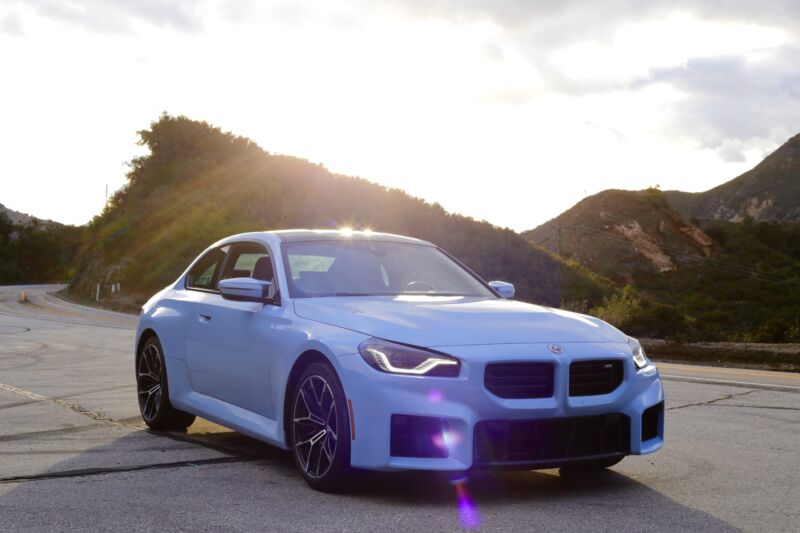
We're at an interesting crossroads in the high-performance enthusiast car market. Running east to west is the adoption of electric vehicles and a slow reduction in internal combustion engine car production. North to south is the progression of ICE horsepower from the factory over the years, and it's unclear how far it continues from here. Coming in diagonally is the weakening demand for manual transmissions—this is sadly where they end.
In the middle of this intersection is the 2024 BMW M2 six-speed manual, hanging its tail out in a massive controlled drift around the edges, expressing one last hurrah as BMW's final object of internal-combustion M car affection.
I recently had the opportunity to pilot BMW's latest, smallest M car through some of Southern California's most fun mountain roads, plus Willow Springs International Raceway's Streets of Willow circuit. When it comes to quickly figuring out this kind of car's powertrain and chassis, I can't think of a better mix of pavement. Here's what makes the latest—and last—six-speed-manual-equipped M2 generation an overall excellent enthusiast coupe.
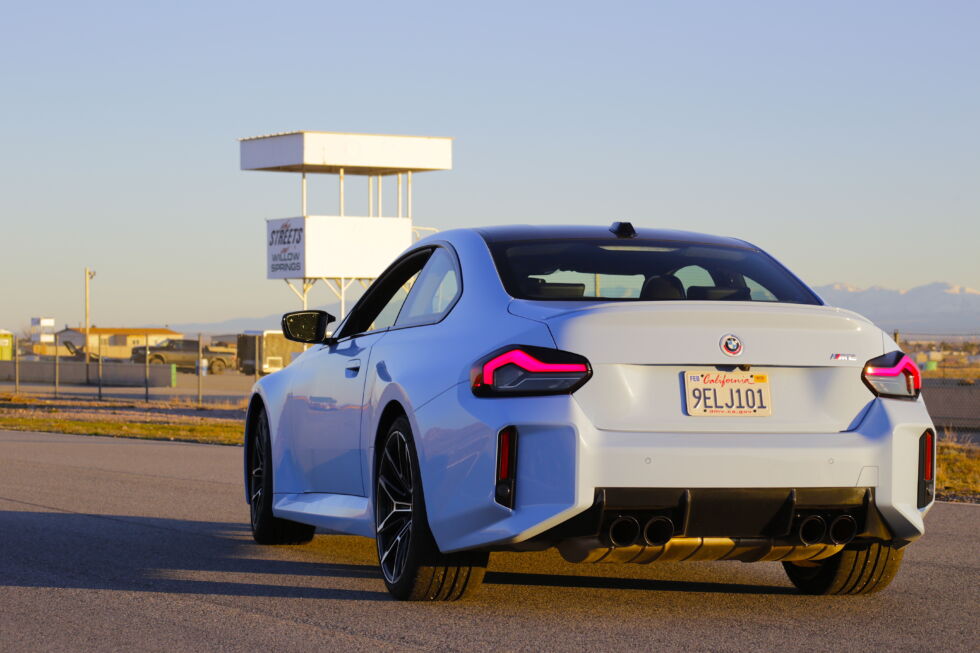
Focused inside-out
Looks are subjective, particularly BMW looks, but I think BMW did a good job on the M2's exterior. Its kidney grilles, headlights, fender flares, exhaust tips, and wide fenders—especially in the rear quarter panels—are attractive. It's a muscular little coupe, and it definitely informs you of its intentions with its massive intakes cut into its front end. Behind them lies a heat exchanger for its engine's air-to-water intercooling (more on that in a bit), plus several other forms of water and oil cooling to ensure long-lasting peak performance, all-twisty-road-and-track-session-long. It's hard to mistake it for a base 2 Series.
AdvertisementInside, it's quite spacious for a coupe and has great visibility all around. My test car included the $9,900 Carbon Package, which gets you comfortable, near-race-bucket carbon fiber seats and a slick carbon roof. I'm 6 feet and 3 inches tall, so the absence of sliding glass up top was a godsend and even allowed me to wear a helmet on track without needing to recline, a rarity in modern cars. The seats are a bit of a pain to slide in and out of, and the left leg bolster pushed inward slightly too much, impeding efficient and comfortable clutch action for my lanky figure. I suspect many folks wouldn't have the same issue, though.
Technology-wise, a crisp 12.3-inch digital instrument cluster and a 14.9-inch touchscreen take up a lot of real estate. BMW's iDrive 8 software is easy to get the hang of, operates quite seamlessly, and has good haptic feedback. Materials quality is overall quite good; all buttons and dials felt substantial, and the Carbon Package includes chic slabs of carbon fiber trim instead of the boring old piano black plastic that's all too common in modern performance cars.
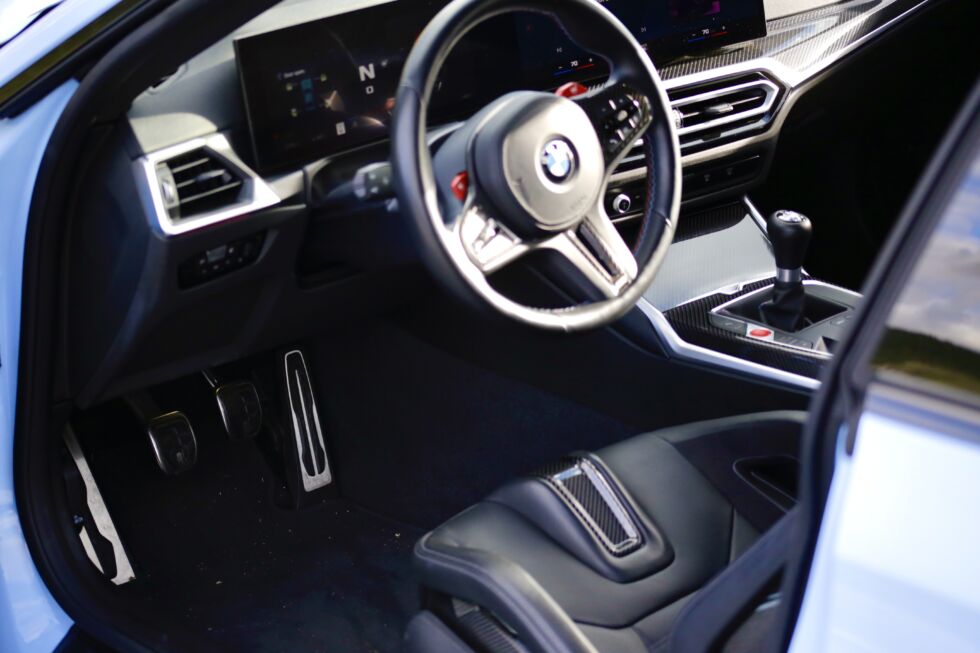
More than enough power
The 2024 M2 pulls no punches. Living under the hood of the car is BMW's twin-turbo 3.0-liter S58 inline-six, which produces 453 hp (338 kW) and 406 lb-ft (550 Nm) of torque. Despite tipping the scales at 3,814 pounds (1,730 kg)—hefty, though on brand for our modern era—the car hits 60 mph (98 km/h) from a standstill in just under four seconds. But you'd swear it feels a second quicker.
There's ample torque all over the rev band, so for the most part, power delivery feels linear compared to what's customary of turbocharged fare. However, once both turbos are pushing peak boost pressure through its big air-to-water intercooler, acceleration becomes downright ravenous higher up, all the way to its 7,200 rpm redline. The bark matches the bite, too: The S58 lets out a snarling baritone roar high in the revs as it shoves occupants deep into the seat at wide-open throttle. Corner-exit and straightaway acceleration was more than ample on Streets of Willow.
The M2's aggressive soundtrack really helps it deliver a comprehensive enthusiast car experience, too. The engine springs to life like race car fare, quickly differentiating itself from a more run-of-the-mill B58 inline-six found in non-M BMWs (though that engine is no slouch, itself). Then, after putting the clutch in and selecting a gear, its revs are more akin to a high-strung, small-displacement motorcycle engine than most other powerplants this side of a McLaren.
The tail pipes' decibel rating is barely socially acceptable in its loudest mode, too. $63,200 to start isn't exactly cheap, but you feel like you're behind the wheel of something that's tailor-engineered for both street performance and capable track use. Its personality gives it an endless sense of occasion—I put in a lot of miles in a week.
So, I quickly found out that fuel economy isn't exactly the M2's forte. A 70-mile (113-km) highway run amounted to a hair over 21 mpg (11.2 L/100 km) while keeping the cruise control set at 75 mph (120 km/h). That's three mpg less than its EPA rating. Its 16 mpg (14.7 L /100 km) city rating diminishes rather quickly, as this thing is just too fun to rip around in. It doesn't help that the tank is 13.7 gallons (52 L), either, which is awfully small for something this heavy and sporting so much power. But with so much power on tap in something this daily-able, it's easy to forgive.
Advertisement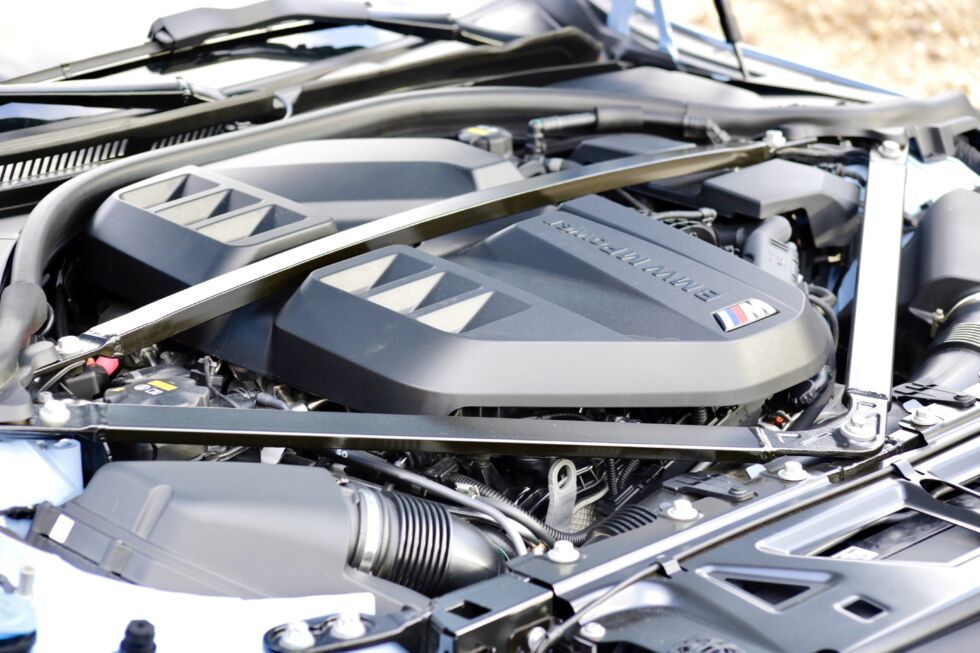
Shifting manually in 2024
The 2024 BMW M2 can be optioned with an eight-speed automatic or six-speed manual gearbox, and neither commands a premium over the other. Word on the street is that BMW is killing the manual option after 2025, and the Bavarian brand itself says the M2 is the last M model to get it. I specifically asked for three pedals because, well, I wanted to get a good feel for it before it's gone forever.
I've had the pleasure of rowing through various modern BMW gearboxes, from my own E82-generation 1 Series' to a buddy's E92 M3's and even an F80 M3's—plus those from a myriad of other modern performance vehicles, like the previous-generation Honda Civic SI and the latest Ford Mustang Dark Horse.
The M2's gearbox isn't exactly stellar. It's rubbery, it feels very isolated from the transmission's mechanical innards, and I occasionally had to quickly shift into second gear before fully engaging first at a stop, which shouldn't be a thing these days.
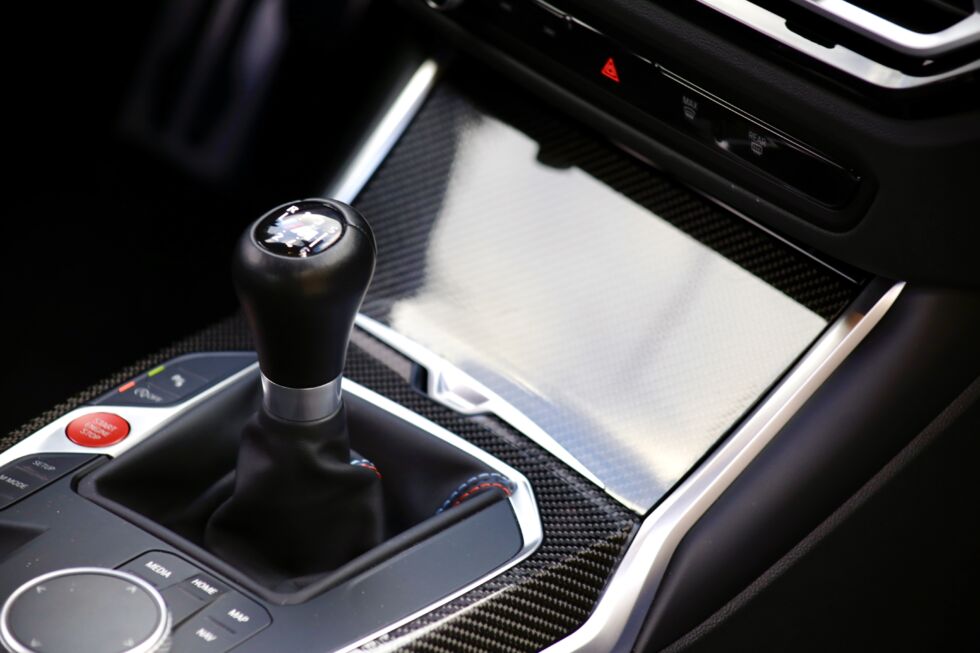
On the plus side, though, there's little side-to-side play in each gear, and the spring is just right. The car's lightly weighted shifter also lacks notchiness, but this gave me a bit of an epiphany on track: The rubbery lack of notch behooves lightning-fast shifts, up and down. I'm not sure if it's engineered that way or if it's a pleasant, unintended side-effect (probably the latter), but I actually dug it. As in some other modern manual sports cars, you can opt to have the M2 blip the throttle for you on downshifts, but it's not necessary with the M2's perfectly placed pedals (for heel-and-toe) and that wonderfully revvy twin-turbo six.
People often bemoan BMWs' modern shifter feel, but one can't deny its great balance of sharp throttle response, ideal pedal placement, and oddly beneficial, rubbery directness.
Remarkably great handling
Completing the M2's well-rounded enthusiast car appeal is top-notch chassis tuning, steering, and braking. Beneath the M2's front wheel arches lives double-joint strut suspension, whereas multilink fare populates the rear arches out back, and adaptive M dampers tie it all together to what BMW calls a very longitudinally and torsionally stiff chassis. With its suspension set to Sport or Sport Plus in the M2's M Setup Menu—just a button away on its center console—its handling is sublime.
First and foremost, body roll was non-existent in Sport Plus. It was such a pleasure to rip through Streets' technical right- and left-handers and the smorgasbord of apexes—all at a good variety of speeds—and feel nothing but planted grip from the M2's 275-front and 285-rear Michelin Pilot Sport 4 S tires. Understeer only started to fade in if I turned in a little too much too early, but otherwise, the car's handling was incredibly neutral. Mid-corner bumps never upset it, either. Its stiff chassis made it quite communicative and helped relay every millimeter of movement in each tire's sidewall—plus every ounce of weight getting shifted around at each corner—to my nervous system. It was a very confidence-boosting experience.
The M2's steering didn't quite live up to its excellent handling, but it was still up to the task. Weight built up well enough in tight corners, it was quite direct, and its perfect ratio made for easy pin-point precision. It even transmitted some slight road texture to my fingertips, which is sadly rare in modern electric power steering.
The same goes for the brakes, which are 15 inches (380 mm) up front and 14.6 inches (370 mm) out back; the pedal felt solid and easy to modulate when set to Sport (this is also configurable in the M Setup menu). However, its strong initial bite faded a bit after a couple of laps, as did overall stopping power. I never noticed any loss of either on SoCal's picturesque mountain roads, but folks who are considering tracking the M2 should look into sturdier brake pads, plus quality DOT 4 brake fluid for good measure.
AdvertisementOne of the M2's technological high cards is what BMW calls M Traction Control (MTC), meaning you get a sliding scale of how much you'd like this portion of its brain to intervene in the event of a slip, from none whatsoever to an extra-nosy nanny. When conditions were just right and traction control was completely off, the M2's generally linear power delivery and excellent handling meant that oversteer was a cinch to hang onto. On the other hand, I really liked having MTC ever-so-slightly there, barely in the way. It even allowed for some light tail-out rascality at corner-exit if I was a little early on the throttle.
Finally, off-track and with the dampers and steering set to Comfort or Sport, the M2 put up with Los Angeles' notoriously crappy roads quite well. My only gripe was the configurable brake pedal; it was too squishy and vague when set to Comfort. Sport was in no way too grabby and was just fine for all occasions. Additionally, toning down the engine's temper to Sport or Efficient made it a touch quieter and less ready-to-pounce. All-in, the 2024 M2 is an excellent dual-purpose daily-slash-twisty-road-slash-track car.
The last manual M car
- The M2 is a great canyon carver.Peter Nelson
- It's a loud car in its loudest mode.Peter Nelson
- iDrive 8 is a good infotainment system.Peter Nelson
- The M2's big face holes allow air to reach heat exchangers.Peter Nelson
- M cars get a different BMW badge from the normal models.Peter Nelson
- The $9,900 carbon package includes a carbon fiber roof, which lowers the center of gravity, along with carbon fiber interior trim and those bucket seats.Peter Nelson
This latest, and last, BMW M2 is nothing short of immense fun. Its rousing powerplant and overall excellent chassis tuning make it quite potent on both paved roads and focused track tarmac, and you'd never mistake it for a non-M offering. Whether from the outside or inside. It doubles as a comfortable everyday ride as well, though some folks may not be too crazy about its mileage—it sure would test even the most economy-minded owners' right-foot restraint on the daily, too.
When it comes to the M2's manual transmission, between demand not being what it used to be and EV adoption slowly increasing, it's a bummer that the three-pedal life's days are numbered. But I'm glad it still is in 2024, even if it may not be the best gear shift out there. It would have been nice to have a little more mechanical feel—after all, aftermarket companies offer a myriad of products for improving previous Bimmer generations' boxes—but I get it. It's just nice to have as much engagement as possible while we still can.

















